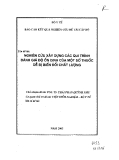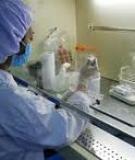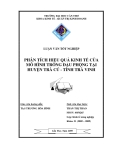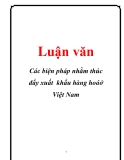Original article
Effects of high temperatures and ash on seed germination of two Iberian pines (Pinus nigra ssp salzmannii, P sylvestris var iberica)
A Escudero S Barrero JM Pita
Dpto Biología Vegetal, EUIT Agrícola, Universidad Politécnica de Madrid, 28040 Madrid, Spain
(Received 1 June 1996; accepted 19 December 1996)
Summary — The effect of high temperatures and ash on seed germination of two Iberian pines (Pinus nigra ssp salzmannii and P sylvestris var iberica) has been studied. These two pines are widely distributed in the oromediterranean and supramediterranean bioclimatological belts of the eastern half of the Iberian Peninsula. Our results are clearly very similar for both pines. Seed cover protects embryos up to 70 °C (germination percentage above 90%), which is a very low temperature for a wildfire, catastrophically failing when this temperature is surpassed. Addition of ash solutions did not modify this trend. As has been previously reported, both pines have photophillous seeds, which indicates that they can regenerate rapidly after disturbance, except wildfires, as our results illus- trate. These results confirm the field observations after very large fires in extensive and homogeneous pine forests (> 10 000 Ha), in the sense that recruitments of both pines are extremely rare after dis- turbance. At a community level, our results seem to indicate that pine formations must be naturally confined to the oromediterranean belt or at permanent stands in spurs, crests or steep rocky slopes where density is very low and wildfires do not become catastrophic. The existense of formations in the supramediterranean belt must be man-induced (landscape changes) and driven, not necessarily plan- ted, and can be rapidly substituted by oak formations after intense wildfires.
ash / heat treatment / Pinus nigra / Pinus sylvestris / seed germination / wildfires
Résumé — Effet des températures élevées et des cendres sur la germination de deux espèces de pins ibériques (Pinus nigra ssp salzmannii et Pinus sylvestris var iberica). L’effet des températures élevés et des cendres sur la germination des graines a été étudié chez Pinus nigra ssp salzmannii et Pinus sylvestris var iberica, pins qui ont une vaste distribution dans les aires oroméditerranéenne et supraméditerranéenne de la moitié est de la péninsule Ibérique. Les résultats obtenus sont voisins pour les deux espèces de pins : le pourcentage de germination, à des températures inférieures à 70 °C, est
* Correspondence and reprints Tel: (34) 1 54 45 58 00; fax: (34) 1 549 300 2
proche au 90 % ; l’augmentation de la températures fait descendre brusquement ce taux de germination et l’addition des cendres ne modifie pas ces résultats. D’autres travaux ont mis en évidence la pho- tosensibilité positive des graines chez les deux espèces de pins ; cette caractéristique permet la rapide régénération de ces formations de pins après perturbations de ces écosystèmes, sauf dans le cas des incendies forestiers. Ces résultats pourraient expliquer les difficultés de régénération après des incen- dies très importants (>10 000 ha) sur forêts très homogènes. Au niveau des communautés, ces résul- tats pourraient aussi expliquer l’apparition des formations de ces pins dans l’aire oroméditerranéenne ou sur des zones rocheuses très localisées, où la densité des formations est très faible et où les incen- dies forestiers ne sont pas catastrophiques. Par ailleurs l’existence des formations de l’aire supra- méditerranéenne est probablement directement ou indirectement liée à l’intervention humaine. D’autre part, elles peuvent rapidement être remplacées, après incendies, par des formations de chênes.
cendres / germination / incendie forestier / Pinus nigra / Pinus sylvestris / température
INTRODUCTION
Pinus nigra ssp salzmannii and several local varieties of P sylvestris are widely distribu- ted on the Iberian peninsula, mainly in the eastern part (Ceballos and Ruiz de la Torre, 1971; Amaral Franco, 1986). The pine- forests dominated by these trees form cli- max communities in the oromediterranean belt and permanent formations are found in spurs or crests on thin rocky soils at lower altitudes (Rivas-Martínez, 1987). In the more moist supramediterranean belt, these two pines are mainly interspersed with oaks (Quercus pyrenaica, Q faginea, Q humilis) and even beeches (Fagus sylvatica) in secondary forests that can cover large areas (Elena-Roselló and Sánchez-Palomares, 1991; Catalán, 1991; Pausas and Fons, 1992). The economic importance of these pine forests is also noteworthy (Ceballos and Ruiz de la Torre, 1971).
(Orlandini and Malcoste, 1972). P hale- pensis and P pinaster, two common Iberian pines, have been characterized as typical pyrophytes, which regenerate well after fire (Acherar et al, 1984; Trabaud and Oustric, 1989a; Castro et al, 1990). However, seve- ral authors have recently noted that both pines are not real pyrophytes (Martínez- Sánchez et al, 1995), as they are not positi- vely stimulated by high temperatures as many Mediterranean shrubs, such as Cista- ceae and Leguminosae (Vuillemin and Bulard, 1981; Troumbis and Trabaud, 1986; Trabaud and Oustric, 1989b; Corral et al, 1990; Tárrega et al, 1992; González-Rabanal and Casal, 1995; Trabaud, 1995). Although P nigra and P sylvestris are considered typi- cal opportunist conifers with high resilience after wildfires and other disturbances (Barbero et al, 1990), they present severe problems in recruitment after intense wild- fires (Trabaud and Campant, 1991). Almost no regeneration was observed 1 year after a large fire in a Pinus nigra forest (15 000 ha) in southern Cuenca, eastern Spain and in Catalonia (> 25 000 ha) (Retana, pers comm).
With these premises in mind several questions arise. First, what is the seed beha- viour of P nigra ssp salzmannii and P syl- vestris after a wildfire? Second, what is the effect of ash, a typical element in the post- fire environment? Third, what are the impli- cations at the community level?
Wildfire has been demonstrated as being a major factor in determining structural and functional features of Mediterranean com- munities (Naveh, 1974). Most Mediterra- nean conifers, excluding P canariensis and several Juniperus taxa, are obligatory seed regenerators after disturbance. When a wild- fire occurs, cones open and trees find an opportunity for their natural regeneration (Walter, 1973). Seeds are normally stimu- lated by light via the phytochrome system as in P sylvestris (Toole, 1973) and P nigra
Experiment 2: effect of temperature and ash
In this paper seeds were subjected to dif- ferent ’fire intensity’ treatments at varying temperatures and lengths of time to simu- late responses to different fire regimes (Gill and Groves, 1981) or microtopographic heterogeneity (Trabaud and Oustric, 1989a). Similarly, different concentrations of an ash solution were used to test the effect of ash on germination. The obtained results were used to discuss the implications of wildfire at the community level.
Two factors were considered in the experimental design: temperature and ash. The temperature was considered at three levels: control, 90 °C/5 min and 130 °C/2.5 min. The ash was also consi- dered at three levels: control and two ash solution: 10 g/L and 20 g/L. Ash (completely burnt mate- rial) was obtained from P sylvestris and P nigra branches and leaves and the ash solution used to moisten petri dishes was prepared following Kee- ley and Keeley (1987). Four replicates of 25 seeds were prepared for each factor/level com- bination (3 x 3). A two-factor ANOVA was sub- sequently performed.
MATERIAL AND METHODS
RESULTS
Pinus nigra Arnold ssp salzmannii (Dunal) Franco and P sylvestris L var iberica Svob seeds, collected in 1995 in the southern Sistema Ibé- rico (Cuenca), were obtained from the Institute for Nature Conservation (ICONA), Ministry of Agriculture. Seeds were stored at 6 °C in darkness in open containers.
Germination tests were performed with 25 seeds per petri dish on filter paper regularly mois- tened with distilled water. Four replicates were used per treatment. The dishes were then placed in controlled environment cabinets at an alter- nating temperature of 15 °C/25 °C with a 16 h light/8 h dark photoperiod (Osram fluorescent tubes L20 W/105, 30-45 Em-2s-1). The crite- rion of germination was visible radicle protu- sion. Germination was checked daily and the germinated seeds were removed.
Temperature treatments up to 70 °C did not seem to affect the germination of P nigra or P sylvestris (figs 1 and 2, and table I). Germination reached high values (> 90%) in all cases, and there were no differences with the control. However, when temperatures surpassed 70 °C, germination decreased significantly (P < 0.001). Heat treatments above 100 °C resulted in almost null ger- mination (< 10%), which seems to indicate that such temperatures cause the seeds to die. The germination behaviour of P nigra and P sylvestris was very similar. The values for T50 (days to reach 50% of germination) showed no significant delays in germina- tion among treatments with high germina- tion responses (tables I and II).
Experiment 1: effect of temperature
In the second experiment ash did not significantly modify the germination per- centage of seeds in these two pines (table II) and no interactions between temperature and ash were found (table III).
DISCUSSION
Based on similar studies (Keeley, 1987; Keeley and Keeley, 1987; Trabaud and Oustric, 1989; Martínez-Sánchez et al, 1995) it was decided to test the following heat treatments, covering a wide range of conditions encountered by seeds during fires: control, 50 °C/3 min, 50 °C/8 min, 70 °C/3 min, 70 °C/5 min, 90 °C/5 min, 100 °C/2 min and 130 °C/2.5 min. Germination percentage, previously subjected to angular trans- formation, was analyzed by a one-way ANOVA. Pairwise comparisons among treatments were performed with the Scheffé test.
Pine species in Mediterranean climates and fire-prone environments have been inter- preted as ’obligate seeders’ (following Kee-
Both pines have been considered gene- ralist conifers with a high capacity for spa- tial selection (Barbero and Quézel, 1989; Barbero et al, 1990). This implies that seeds achieve a rapid recovery after fire or other disturbances (Barbero et al, 1990). As pre- viously demonstrated, pine seed germina- tion is stimulated by light via the phyto- chrome system (Thanos and Skordilis, 1987). This is also true for P nigra and P sylvestris (Orlandini and Malcoste, 1972; Toole, 1973; Orlandini and Bulard, 1975). This clearly indicates the photophilous nature of these two pines, which allows for the germination of their seeds mainly in open and well-illuminated areas. However, according to Trabaud and Campant (1991), Trabaud (1995) and our field observations, recruitment after wildfire is not efficient for these pines. They present good biological and ecological selection to colonization after disturbance but not after intense fires, mainly crown fires.
ley and Zedler, 1978). After severe wild- fires, genets are almost always killed and reproduction, which is normally very effec- tive (Trabaud et al, 1985; Barbero et al, 1987; Mansanet, 1987; Papió, 1987; Tha- nos et al, 1989; Martínez-Sánchez et al, 1995; Thanos et al, 1996), depends entirely on seeds. Traditionally, Mediterranean pines have been considered as ’active pyrophytes’ (Kuhnholtz-Lordat, 1958; Trabaud, 1970; Le Houerou, 1974), but Trabaud (1987) introduced the more realistic term ’adapted to fire’ to describe their behaviour. Martínez- Sánchez et al (1995) indicate that the seed germination of P pinaster and P halepen- sis from xeric southern Spain, is not favou- red by an increase in temperature, although the seed cover can protect the embryo at a wide range of temperatures (germination only decreased above 200 °C). Thus, these plants can be interpreted as efficient colo- nizers in burnt areas, although some diffi- culties have been reported in the reesta- blishment of P pinaster after intense fires (Castro et al, 1990).
Our results suggest an even more res- tricted behaviour for P nigra and P sylves- tris after wildfires. The seed cover only confers a smooth protection to heat shocks. Thus, temperatures above 70 °C become lethal and germination is not affected by ash. Reyes and Casal (1995) found that the critical point must be located between 90°C /1 min and 90 °C /5 min for P sylves- tris seeds. A similar effect of ash on seed germination has been reported for P hale- pensis (Neéman et al, 1993). Ash from totally consumed wood, ie, very intense wildfires, has shown no positive effect on seed germination (Trabaud and Casal, 1989; Neéman et al, 1993; González-Rabanal and Casal, 1995), whereas charred wood can facilitate germination, probably via nitrates (Keeley, 1987; Thanos and Rundel, 1995) or even via ammonium (Christensen, 1973; Christensen and Muller, 1975).
On the Iberian Peninsula, pine forests dominated by P nigra are mainly found in the southern half, and those dominated by P sylvestris in central and northern Spain. These forests are considered ’climax’ com- munities of the highest mountains on the oromediterranean belt (Rivas-Martínez, 1987; Peinado and Rivas-Martínez, 1987), whereas they form permanent communities on rocky sites (such as spurs, crests and steep slopes) (Regato and Escudero, 1990). In such situations, tree population density results in a patchy distribution of scattered, low cover forests, surrounded by a general matrix of creeping scrubs, caespitose grasses and bare rock outcrops. Although wildfires in these forests vary according to the fuel load and the weather, they are normally sur- face fires that rarely turn into catastrophic crown fires. Only on the lower boundary of the oromediterranean belt is the canopy almost continuous and can the fuel load reach critical values leading to severe fires as reported for supramediterranean forests. Thus, under the fire regime of high moun-
tains, oromediterranean pines are highly competitive. Many trees can survive, as fire scars in very old scot pines indicate (Di and Ende, 1990), and the postfire environment leads to successful pine recruitment by seeds, with almost no competiton from other trees.
Rivas-Martínez, 1987). From an economical point of view, P nigra ssp salzmannii and P sylvestris are the species most widely used in Iberian forestry. The landscape changes induced by wildfire as a consequence of forest homogenization and fuel loading are significant, as extensive territories depend almost exclusively on the exploitation of these forests.
ACKNOWLEDGEMENTS
We thank Lori J De Hond for her linguistic assis- tance. This work was financied by a CAM project No 06M/003/96.
REFERENCES
Acherar M, Lepart J, Debussche M (1984) La coloni- sation des friches par le pin d’Alep (Pinus hale- pensis Mill) en Languedoc méditerranéen. Acta Oecologica, Oecol Plant 19, 179-189
Amaral Franco J (1986). Pinaceae. In: Flora Iberica I: Plantas vasculares de la Península Ibérica e Islas Baleares (Lycopodiaceae-Papaveraceae) (S Castroviejo et al, ed), CSIC Madrid
Barbero M, Quézel P (1989) Structures, architectures forestières à sclérophylles et prévention des incen- dies. Bull Ecol 2, 7-14
Barbero M, Bonin G, Loisel R, Quézel P (1990) Changes and disturbances of forest ecosystems cau- sed by human activities in the western part of the mediterranean basin. Vegetatio 87, 151-173 Castro JF, Bento J, Rego F (1990) Regeneration of Pinus pinaster forests after wildfire. In: Fire in Ecosystem Dynamics (JG Goldammer, MJ Jenkins, ed). SPB Academic Publishing, The Hague, 71-75 Catalán G ( 1991 ) Regiones de Procedencia de Pinus sylvestris L, Pinus nigra Am ssp salzmannii (Dunal) Franco. MAPA, Madrid
Barbero M, Bonin G, Loisel R, Miglioretti F, Quézel P (1987) Incidence of exogenous factors on the rege- neration of Pinus halepensis after fires. Ecol Medit 12, 40-51
Christensen NL (1973) Fire and the nitrogen cycle in
Californian chaparral. Science 181, 66-68
On the other hand, there are extensive forests with milder macroclimatic condi- tions located on most of the Iberian moun- tains of the eastern half in the supramedi- terranean belt. These forests have been suffering catastrophic fires (> 10 000 ha) for the last two decades (Vázquez and Moreno, 1993). This is most likely to be due to landscape homogenization resulting from a decrease in man-induced distur- bances, as reported for most of the northern Mediterranean forest ecosystems (Barbero et al, 1990). After wildfires almost all seeds, both in the canopy and the soil, are killed. Dissemination of anemochorous seeds from surviving edge pines, is strongly limited after very large fires as they rarely surpass 100 m, as in the case of P halepensis and P brutia (Trabaud et al, 1985; Barbero et al, 1987; Richardson, 1988; Thanos et al, 1989; Thanos et al, 1996). Subsequently, resprou- ters, such as different Quercus species, which are usually interspersed in the sub- canopy, or seeders, such as Betula, achieve early control of the newly opened space (Ceballos and Ruiz de la Torre, 1971) and pines can become locally extinct. From a community perspective, this implies great landscape and economical changes. In only a few years, very productive pine forests are transformed into sclerophyllous (Q ilex and Q rotundifolia) and deciduous oak forests (Q humilis, Q faginea and Q pyre- naica) as pointed out by Retana (pers comm) after some large fires in Catalonia (Spain). This seems to agree with the idea that these supramediterranean extensive pine forests are, in many cases, man-induced and the mature or climax communities are normally oak forests, except in sunny and rocky areas where pines can take refuge (Peinado and
Ceballos L, Ruiz de la Torre J ( 1971 ) Árboles y Arbus- tos de la España Peninsular. ETSI Montes, Madrid Corral R, Pita JM, Pérez-García F (1990) Some aspects of seed germination in four species of Cistus L. Seed Sci Technol 18, 321-325
Papió C (1987) Regeneració del pi blanc despres d’un incendi. Quaderns Ecologia Aplicada. 10, 83-91 Pausas JG, Fons, J (1992) Estructura i el creixement d’algunes pinedes en diferents condicions topo- gráfiques. Fol Bot Misc 8, 199-213
Peinado M, Rivas-Martínez S (1987) La Vegetación de España. Publicaciones Universidad de Alcalá de Henares, Madrid.
Di X, Ende J (1990) The forest conflagration of May 1987 in Northeastern China. In: Fire in Ecosystem Dynamics (JG Goldammer, MJ Jenkins, eds), SPB Academic Publishing, The Hague, 169-174 Elena-Roselló R., Sánchez-Palomares (1991) Los Pinares Españoles de Pinus nigra Arn: Síntesis Ecológica. MAPA, Madrid
Regato P, Escudero A (1990) Caracterización fitoe- cológica de las comunidades de Pinus nigra ssp. salzmannii en los afloramientos rocosos del Sis- tema Ibérico Meridional. Bot Complutensis 15, 149-161
Gill AM, Groves RH (1981) Fire regimes in heath- lands and their plant ecologic effects. In: Ecosystems of the World. Vol 9B: Heathland and Related Shru- blands (RL Specht, ed), Elsevier, Amsterdam, 61-84
Reyes O, Casal M (1995) Germination behaviour of three species of the genus Pinus in relation to high temperatures suffered during fores fires. Ann Sci For 52, 385-392
Christensen NL, Muller CH (1975) Effects of fire on factors controlling plant growth in Adenostoma chaparral. Ecol Monogr 45, 29-55
González-Rabanal F, Casal M (1995) Effect of high temperatures and ash on germination of ten spe- cies from gorse shrubland. Vegetatio 116, 123-131 Keeley JE ( 1987) Role of fire in seed germination of woody taxa in California chaparral. Ecology 68, 434-443
de Vegetación de España. MAPA, Madrid
Keeley JE, Keeley SC (1987) Role of fire in the ger- mination of chaparral herbs and suffrutescents. Madroño 34, 240-249
Tárrega R, Calvo L, Trabaud L (1992) Effect of high temperatures on seed germination of two woody leguminosae. Vegetatio 102, 139-147
Thanos CA, Rundel PW ( 1995.) Fire-followers in cha- parral: nitrogenous compounds trigger seed ger- mination. J Ecol 83, 207-216
Keeley JE, Zedler PH ( 1978) Reproduction of chapar- ral shrubsafter fire: a comparison of sprouting and seeding strategies. Amer Midl Natur 99, 142- 161 Kuhnholtz-Lordat G (1958) L’écrant vert. Memoires du Muséum national d’histoire naturelle, Série B 9, Paris
Thanos CA, Daskalakou EN, Nikolaidou S (1996) Early post-fire regeneration of a Pinus halepensis forest on Mount Párnis, Greece. J Veg Sci 7, 273-280
Richardson DM (1988) Age structure and regenera- tion after fire in a self- sown Pinus halepensis forest on the Cape Peninsula, South Africa. SA J Bot 54, 140-144. Rivas-Martínez S (1987) Memoria del Mapa de Series
Le Houérou HN ( 1974) Fire and vegetation in the Mediterranean Basin. Tall Timbers Fire Ecology Conference 13, 237-277
Thanos CA, Skordilis A ( 1987) The effects of light, temperature and osmotic stress on the germination of Pinus halepensis and P brutia seeds. Seed Sci Technol 15, 163-174
Thanos C, Marcou S, Christodoulakis D, Yannitsaros A (1989) Early post-fire regeneration in Pinus bru- tia forest ecoystems of Samos island (Greece). Acta Oecologica, Oecol Plant 10, 79-94
Toole VK (1973) Effects of light, temperature and their interactions on the germination of seeds. Seed Sci Technol 1, 339-396
Mansanet CM (1987) Incendios forestales en Alicante. Estudio de la Evolución de la Vegetación Que- mada. Caja de Ahorros Provincial, Alicante Martínez-Sánchez JJ, Marín A, Herranz JM, Ferrandis P, De las Heras J (1995) Effects of high tempera- tures on germination of Pinus halepensis Mill. and P pinaster Aiton ssp. pinasler seeds in southeast Spain. Vegetatio 116, 69-72
Trabaud L (1970) Quelques valeurs et observations sur la phytodynamique des surfaces incendiées dans le Bas-Languedoc. Naturalia Monspeliensia, Serie Bot 21, 231-242
Naveh Z (1974) Effects of fire in the Mediterranean region. In: Fire and Ecosystems (TT Kozlowski, CE Ahlgren, eds), Academic Press, New York, 401-434
Trabaud L (1987) Dynamics after fire of sclerophyllous plant communities in the Mediterranean basin. Ecol Medit 13, 25-37
Neéman G, Meir I, Neéman R (1993) The effect of ash on the germination and early growth of shoots and roots of Pinus, Cistus and annuals. Seed Sci Technol 21, 339-349
Trabaud L, Campant C ( 1991 ) Difficulté de recoloni- sation naturelle du pin de Salzmann Pinus nigra Arn. ssp. salzmannii (Dunal) Franco après incendie. Biol Conserv 58, 329-343
Trabaud L (1995) Modalités de germination des cistes et des pins méditerranéens et colonisation des sites perturbés. Rev Ecol (Terre Vie) 50, 3-14 Orlandini M, Bulard C (1975) Principales caractéris- tiques de la germination des graines photosensibles de pins ; comparaison avec d’ autres matériels. Tra- vaux scientifiques du parc national de la Vanoise 6, 95-114
Orlandini M, Malcoste R (1972) Étude du phytochrome des graines de Pinus nigra Arn par spectrophoto- metric bichromatique in vivo. Planta 105, 310-316
Vázquez A, Moreno JM (1993) Sensitivy of fire occur- rence to meteorological variables in Mediterranean and Atlantic areas of Spain. Landscape and Urban Planning 24, 129-142
Troumbis A, Trabaud L (1986) Comparison of repro- ductive biological attributes of two Cistus species. Acta Oecologica Oecol Plant 7, 235-250 Trabaud L, Casal M ( 1989) Réponses des semences de Rosmarinus officinalis à différents traitements simulant une action de feu. Acta Oecologica Oecol Applic 10, 355-363
Vuillemin J. Bulard C (1981) Écophysiologie de la germination de Cistus albidus L. et Cistus mons- peliensis L. Naturalia Monspeliensia Serie Bot 46,1-11 Trabaud L, Michels C, Grosman J (1985) Recovery of burnt Pinus halepensis Mill. Forest. II. Pine recons- titution after wildfire. For Ecol Manag 13,167-179 Trabaud L, Oustric J ( 1989a) Influence du feu sur la germination des semences de quatre espéces ligneuses méditerranéennes à reproduction sexuée obligatoire. Seed Sci Technol 17, 589-599
Trabaud L, Oustric J (1989b) Heat requirements for seed germination of three Cistus species in the gar- rique of Southern France. Flora 183, 321-325 Walter H (1973) Vegetation of the Earth in Relation to Climate and Ecophysiological Conditions. Springer Verlag, New York




































